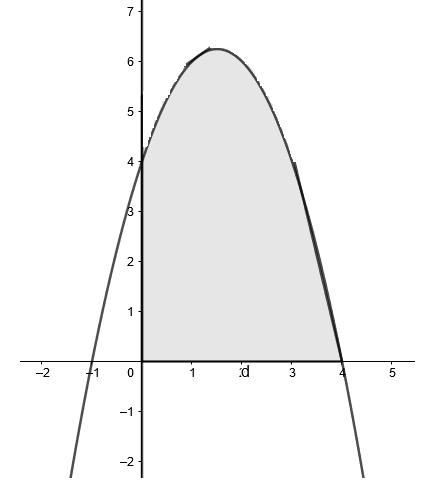
Answer
499.2k+ views
Hint: Try to find where the curve cuts the $x$ axis. First try to make a rough sketch. Then find the area under the curve using integral.
Note that a quadratic function always represents a parabola.
So, first of all let’s try plotting the curve considering various values,
Note that at \[x=0,y=4\]
And at \[y=0,\left( x-4 \right)\left( x+1 \right)=0\] or \[x=4,-1\]
Use the above observations to plot the graph.

The shaded region is the required area.
Hence, we can now find the area by integrating the function from $x=0$ to $x=4$.
The formula of finding the area enclosed by $f(x)$ between $x=a$ and $x=b$ can be written as $=|\int\limits_{a}^{b}{f(x)dx|}$.
So the required area under the curve is,
\[\text{Area}=\int\limits_{0}^{4}{\left( 4+3x-{{x}^{2}} \right)dx}\]
Now we know the integration of sum of functions is sum of individual integration of the functions, i.e.,
\[\text{Area}=\int\limits_{0}^{4}{4dx}+\int\limits_{0}^{4}{\left( 3x \right)dx}-\int\limits_{0}^{4}{\left( {{x}^{2}} \right)dx}\]
On integrating, we get
\[Area=\left[ 4x \right]_{0}^{4}+3\left[ \dfrac{{{x}^{2}}}{2} \right]_{0}^{4}-\left[ \dfrac{{{x}^{3}}}{3} \right]_{0}^{4}\]
Applying the limits, we get
\[Area=\left[ 4(4)-4(0) \right]+3\left[ \dfrac{{{4}^{2}}}{2}-\dfrac{{{0}^{2}}}{2} \right]-\left[ \dfrac{{{4}^{3}}}{3}-\dfrac{{{0}^{2}}}{3} \right]\]
On solving, we get
\[Area=16+24-\dfrac{64}{3}\]
Taking the LCM, we get
\[Area=\dfrac{40\times 3-64}{3}\]
\[Area=\dfrac{40\times 3-64}{3}=\dfrac{120-64}{3}\]
\[Area=\dfrac{56}{3}\]sq. units
Therefore the area under the curve is \[\dfrac{56}{3}\] sq. units.
Note: The possibility of mistake is that students might take the lower limit as \[-1\] considering the curve and forget to note that it is asked to find the area of the curve with the coordinate axes, so the lower limit will be \[0\].
Note that a quadratic function always represents a parabola.
So, first of all let’s try plotting the curve considering various values,
Note that at \[x=0,y=4\]
And at \[y=0,\left( x-4 \right)\left( x+1 \right)=0\] or \[x=4,-1\]
Use the above observations to plot the graph.

The shaded region is the required area.
Hence, we can now find the area by integrating the function from $x=0$ to $x=4$.
The formula of finding the area enclosed by $f(x)$ between $x=a$ and $x=b$ can be written as $=|\int\limits_{a}^{b}{f(x)dx|}$.
So the required area under the curve is,
\[\text{Area}=\int\limits_{0}^{4}{\left( 4+3x-{{x}^{2}} \right)dx}\]
Now we know the integration of sum of functions is sum of individual integration of the functions, i.e.,
\[\text{Area}=\int\limits_{0}^{4}{4dx}+\int\limits_{0}^{4}{\left( 3x \right)dx}-\int\limits_{0}^{4}{\left( {{x}^{2}} \right)dx}\]
On integrating, we get
\[Area=\left[ 4x \right]_{0}^{4}+3\left[ \dfrac{{{x}^{2}}}{2} \right]_{0}^{4}-\left[ \dfrac{{{x}^{3}}}{3} \right]_{0}^{4}\]
Applying the limits, we get
\[Area=\left[ 4(4)-4(0) \right]+3\left[ \dfrac{{{4}^{2}}}{2}-\dfrac{{{0}^{2}}}{2} \right]-\left[ \dfrac{{{4}^{3}}}{3}-\dfrac{{{0}^{2}}}{3} \right]\]
On solving, we get
\[Area=16+24-\dfrac{64}{3}\]
Taking the LCM, we get
\[Area=\dfrac{40\times 3-64}{3}\]
\[Area=\dfrac{40\times 3-64}{3}=\dfrac{120-64}{3}\]
\[Area=\dfrac{56}{3}\]sq. units
Therefore the area under the curve is \[\dfrac{56}{3}\] sq. units.
Note: The possibility of mistake is that students might take the lower limit as \[-1\] considering the curve and forget to note that it is asked to find the area of the curve with the coordinate axes, so the lower limit will be \[0\].
Recently Updated Pages
Fill in the blanks with suitable prepositions Break class 10 english CBSE

Fill in the blanks with suitable articles Tribune is class 10 english CBSE

Rearrange the following words and phrases to form a class 10 english CBSE

Select the opposite of the given word Permit aGive class 10 english CBSE

Fill in the blank with the most appropriate option class 10 english CBSE

Some places have oneline notices Which option is a class 10 english CBSE

Trending doubts
Fill the blanks with the suitable prepositions 1 The class 9 english CBSE

How do you graph the function fx 4x class 9 maths CBSE

When was Karauli Praja Mandal established 11934 21936 class 10 social science CBSE

Which are the Top 10 Largest Countries of the World?

What is the definite integral of zero a constant b class 12 maths CBSE

Why is steel more elastic than rubber class 11 physics CBSE

Distinguish between the following Ferrous and nonferrous class 9 social science CBSE

The Equation xxx + 2 is Satisfied when x is Equal to Class 10 Maths

Differentiate between homogeneous and heterogeneous class 12 chemistry CBSE




